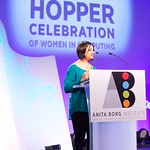Creativity was in high demand even before the event began. Organizers, composed of many UW Engineering students, were faced with many challenges and unanswered questions. How would they provide secure internet to the 1,000 participants and their many devices? How would they keep participants informed and in touch with each other? How were they going to get large volumes of information from would-be competitors without scaring them off? In the end, they solved these problems and more; successes they speak about with the same level of pride as many of the hackers.
The Hack the North team made use of the skills they learned at school. Brendan McGaffey, a Mechanical Engineering student, used AutoCAD to draw the blueprints for rooms. He then used the diagrams to optimize seating and desk arrangements, while assuring adherence to the fire code.
Of course, Hack the North would not be possible without the help of several volunteers, who helped organizers facilitate the smooth operation of the event. However, Vic Vu, founder/organizer of Hack the North mentioned that “the engineering faculty has been a huge help; [Dean of Engineering] Pearl Sullivan has been a huge help from the start. She’s the reason we got E5 [and Sam Altman, president of Y Combinator].”
To keep hackers in the loop, the UW student organizers built two mobile apps, one for iOS and one for Android. The app included important schedule information and a directory of organizers, sponsors and mentors. As an added bonus, it served as a great, painless way to connect people when they needed to.
Making sure that participants had uninterrupted, secure internet was also a big priority. E5 is generally not intended for the continuous, intense use of several thousand devices. Valentin Tsatskin, the User Experience expert and a 3rd year SYDE student, worked around-the-clock with the Information Systems and Technology (IST) department to expand the number of Wi-Fi access points in the building. They also placed switches in concentrated areas, which helped increase device capacity in E5 to 3,000+ devices.
Space for an event like this is limited. Early on, the 1,000 participant cap posed a large challenge for organizers. How were they supposed to screen the multitudes of applicants? To find the most motivated and innovative people, they screened for technical experience and creative drive. Ultimately, this called for the use of analytics and a change in the application user interface. Alongside these two implementations, the team also employed the usage of software suites including GitHub, Slack, Base, and Streak in order to develop and manage the underlying framework of the entire event.
The team originally had an argument surrounding the conversion rate for longer forms, as compared to shorter ones. When only a long form was used, they noticed that people were stopping signing up halfway through the process.
Tsatskin said, “We got tired of arguing for an hour, and I said ‘let’s just test it, there’s no point in arguing.” We pulled an all-nighter creating the horizontal sign up form you see today. We tested it for a week and found that even though we had the exact same questions, the horizontal form had double the conversion rate of the long entry form.”
The form was designed with simplicity and ease-of-use in mind. Vu says, “People’s hands didn’t have to leave their keyboards to scroll or click into boxes to reply. Users did not have to ever take their fingers off the keyboard to scroll. They just had to type and hit enter. It was really neat.”
In the end, it was worth it, of the applicants accepted, 91.58% confirmed that they would be able to attend. Graduate students and roughly 50 high school students also contributed to the hacker population, bringing the total to about 1,000 hackers.
When it comes down to it, Hack the North was successful from all perspectives. The general sentiment among hackers, sponsors, and start-up incubators was overwhelmingly positive. UC Berkeley student Eva Zheng mentioned that “[Hack the North] has been by far one of the most impressive hackathons I’ve ever been to. Huge, huge props to you Waterloo.” After the Hackathon, Altman tweeted that he thought “waterloo is the most impressive up-and-coming startup city i’ve been to.”
It’s clear that anyone involved in Hack the North, especially the team behind it, should be wildly impressed with the end-products – impressive hacks and a stellar event.




Leave a Reply